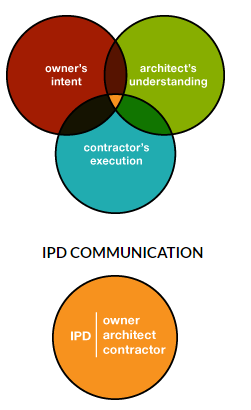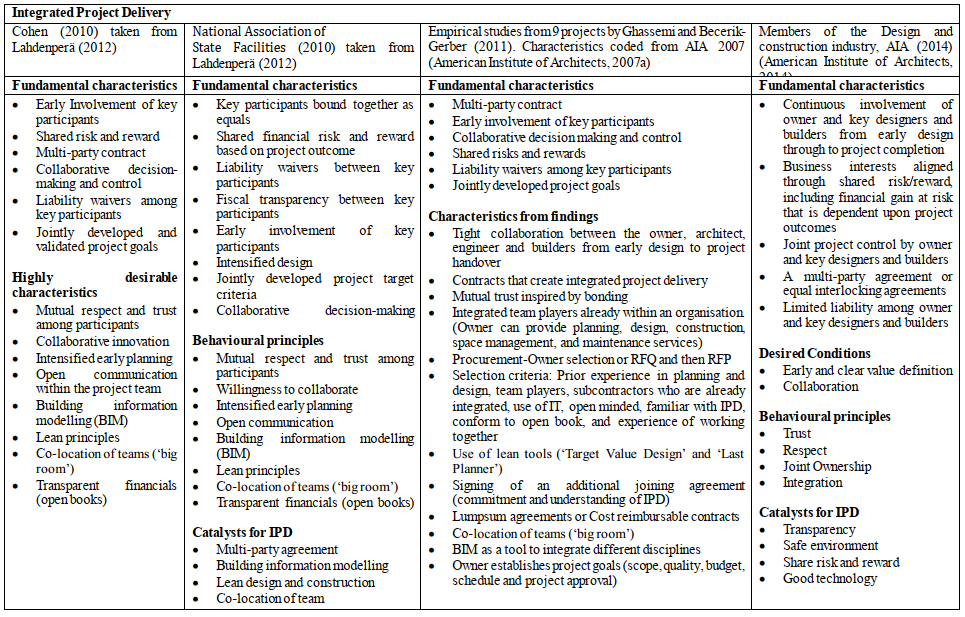Integrated Project Delivery (IPD)
Contents |
Abstract
Integrated project delivery (IPD) is an emerging construction project delivery system that aligns different stakeholders’ interests and objectives, while collaboratively involving key participants very early in the project timeline. It is distinguished by a multiparty contractual agreement that incentivizes collaboration and allows risks and rewards to be shared among the parties of the contract. IPD is becoming increasingly popular with various organizations expressing interest in its benefits to the construction industry. The objective of the article is to provide a description of the IPD method and a short discussion on how it has been rising as a promising method to avoid some of the inefficiencies of traditional contracting systems, as a way to reduce the conflictual relationships between the parties involved in construction projects and maximize construction project success. Furthermore, This article seeks to illustrate what are the main benefits of IPD and address the main obstacles that refrain from unlocking the value of IPD as a precursor of a larger adoption in the industry. IPD has emerged as a solution, although its implementation is not without challenges and limitations.
Definitions of IPD
There is no single definition for IPD. In fact, numerous definitions can be found throughout published studies and reports, some of the definitions continue to evolve. Mathews and Howell (2005) define IPD as “a relational contracting approach that aligns project objectives with the interests of key participants.” Formally, Integrated project delivery (IPD) is defined as a project delivery approach that integrates people, systems, business structures and practices into a process that collaboratively harnesses the talents and insights of all participants to optimize project results, increase value to the owner, reduce waste and maximize efficiency through all phases of design, fabrication, and construction. [1] . (American Institute of Architects)
IPD principles can be applied to a variety of contractual arrangements and IPD teams can include members well beyond the basic triad of owner, architect, and contractor. In all cases, integrated projects are uniquely distinguished by highly effective collaboration among the owner, the prime designer, and the prime constructor, commencing at early design and continuing through to project handover.
The current form of IPD was born out of the general belief that traditional contracting approaches create barriers to collaboration, transparency and the trust needed to truly collaborate; hence the rise of the multi-party agreement. The intent of the multi-party agreement is to create a contractual vehicle that removes barriers to collaboration (i.e., protecting profit, blaming others, hiding contingency and the mentality of every company for itself). There are many IPD proponent in the industry who believe this environment can only be created through the use of a multi-party agreement in which there are a shared risk/reward pool and no traditional financial cost guarantees.
Principles of Integrated Project Delivery
Allison is one of the developers of the American Institute of Architects [1], known as the "bible" of IPD. The guide sets out the following principles to be followed for successful IPD implementation:
- Mutual Respect and Trust: All involved parties-owner, designer, contractor consultants, subcontractors, and suppliers realize the value of collaboration and commit to teamwork in the project's best interest.
- Mutual Benefit and Reward: IPD compensation recognizes and rewards early involvement. Compensation is based on added value, and it rewards positive behaviour, often by providing incentives tied to project goal achievement.
- Collaborative Innovation and Decision Making Innovation: The free exchange of ideas is supported, and ideas are evaluated by merit, not by status or role. Major decisions are weighed by and possible, made by unanimous judgement.
- Early Involvement of Key Participants: Key participants are involved as early as is practical. Decision making improved by the inrush of key participants' expertise, and this shared knowledge is most profound during the projects early stages when informed judgments have the highest impact.
- Early Goal Definition: Project aims are developed and agreed upon early in the process and upheld by all participants, Insights from every participant are valued to support innovation and superior performance.
- Intensified Planning: The point of IPD Isn't to make less of a design effort. but rather to advance design results in order to streamline and shorten the much more costly construction effort.
- Open Communication: Direct and honest communication among team members is fundamental. In a no-blame culture, the goal is to identify and resolve problems rather than assign liability or blame When disputes arise, they are acknowledged as they happen and quickly resolved.
- Appropriate Technology: IPD often relies on cutting edge technologies. Specifying which technologies you will use at the start of the project maximizes interoperability and technologies that support interoperable data exchanges are essential to project support.
- Organization and Leadership: All team members must be committed to the goals and values of the project team. Leadership is given to the most capable team member based on specific situations. Clearly define roles, but keep in mind that creating artificial barriers can tamp down open communication and risk-taking.
Figure 2 shows the fundamental characteristics from the latest version of the AiA guide (2014) and the primary behaviour are derived from the literature. Trust and collaboration is the basis for all main principles. It also further suggested that principles should be used in order to reduce waste and optimise efficiency.
IT shows also the defining principles of IPD are to create a climate of trust and collaboration for implementing the goals of the project. Such a relationship requires honest and open communication and only then can the parties respect each other and establish a trustful relationship. Other key elements include sharing, commitment, predictability, ownership, reliability and empowerment. It is important that all parties are meeting their obligations, looking out for other party’s interests as well as their own and acting honestly and with integrity, without hidden agenda, this behaviour empowers the team to trust and collaborate towards continuous improvement.
Differences between IPD and traditional delivery methods
Integrated Project Delivery operates differently than conventional project management methods but often results in more productivity and efficiency and reduced risk and losses. The focus shifts from “how does my company succeed on this project” to “how do we ALL succeed on this project”.
Multi-Party Agreements
Benefits of IPD
Challenges/ Limitations
Bibliography
References
- ↑ 1.0 1.1 Integrated Project Delivery: A Guide https://www.aiacontracts.org/resources/64146-integratedproject-delivery-a-guide/ American Institute of Architecture (2007)

